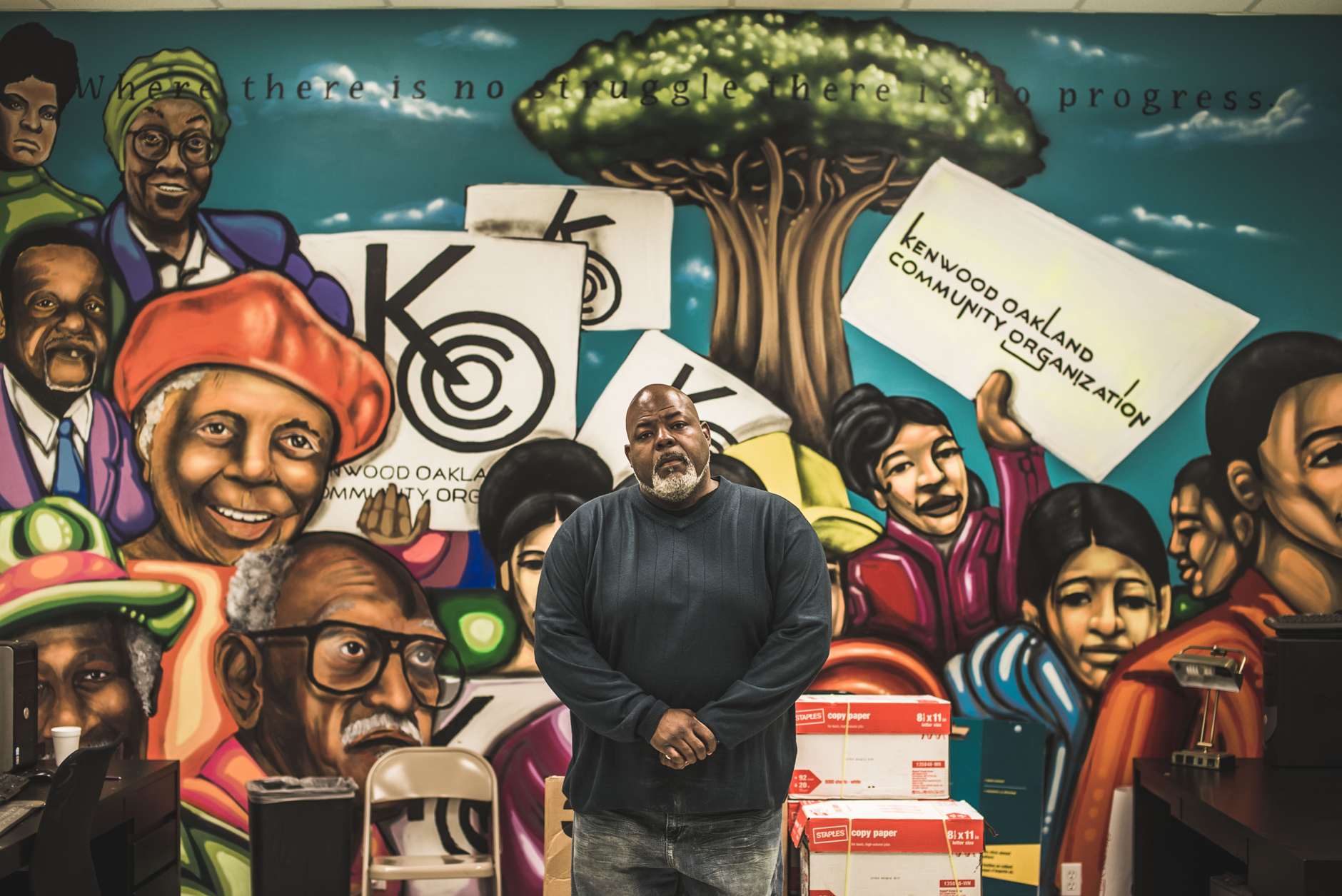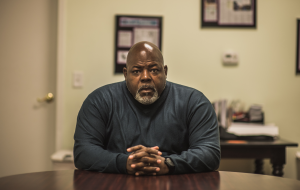
“People need to know the history of where you stand and where you are.” With those words, Jeanette Taylor set the tone of the Bronzeville Education Summit, a gathering of neighborhood students, parents, and teachers held at Mollison Elementary on January 20. Taylor has a son at Mollison and serves on the Local School Council; she also works with the Kenwood Oakland Community Organization (KOCO), which organized the summit. “We have not overcome,” said Taylor, acknowledging the event’s timing on Martin Luther King, Jr. Day. “But we’re coming.”
One of KOCO’s major initiatives—and the heart of its Education Summit event—is the Coalition to Revitalize Dyett High School, which aims to keep Walter H. Dyett High, at 51st and St. Lawrence, open after a closure currently slated for 2015. Citing poor performance, the Board of Education voted to close Dyett in 2012; if the closure goes through, the seventy-eight juniors and seniors who are currently enrolled will be the last students to graduate. Once that happens, one elementary school parent said, “There will not be a neighborhood high school that I have the right to send my child to.”
Instead, students will attend Wendell Phillips Academy, two miles north of Dyett. According to CPS’s annual school progress reports, Phillips has been on probation for eighteen years, and its students’ test scores and graduation rates are only marginally higher than Dyett’s. Moreover, parents say they feel no connection to Phillips: “It feels like it’s in another world,” the elementary school parent said. Aside from Phillips, other high school options for local residents include King College Prep, where students must apply for enrollment, and Kenwood Academy, which automatically admits students living in the neighborhood and accepts applications from students around the city. (Kenwood is already at 111-percent capacity.)
Working with community members and other local organizations, KOCO hopes to convince CPS to reopen Dyett under a new name: Walter H. Dyett Global Leadership and Green Technology High School. This new incarnation of Dyett would emphasize global studies and agricultural science, and incorporate the adjacent Washington Park Green Youth Farm directly into its curriculum. A collaboration between Dyett and the Chicago Botanic Garden, the farm already offers programming and summer employment opportunities to Dyett students.
Dyett,” says Jitu Brown, KOCO’s education organizer, “is the poster child of CPS sabotage.” A hearty man with the presence and oratorical skill of an experienced organizer, Brown is the professional, neatly-bearded face of the Coalition.
At the crux of his argument is a 2012 study of CPS school actions from the Collaborative for Equity and Justice in Education, a program at the University of Illinois at Chicago. The report highlights Dyett as an example of the “Three Ds of Chicago School Reform: Destabilization, Disinvestment, and Disenfranchisement,” and argues that recent CPS decisions set the school up to underperform.
Since 2001, the report says, “CPS has closed, turned around, or converted to charter or selective enrollment twenty area schools near Dyett.” Four different principals, the report points out, have led Dyett in that time. Both the report and members of the coalition conclude that these changes in leadership and enrollment population have prevented the school from adequately serving its students.
A constant issue in the school’s tumultuous past, the report maintains, has been the lack of needed resources. Dyett did not receive additional resources from the district when it was converted from a middle school to a high school in 1999, nor when it was designated to receive students from Englewood High School when it closed in 2006. Unable to afford honors, Advanced Placement, and art classes, Dyett currently offers these courses online only.
Rico Gutstein, one of the authors of the report, is working with the Coalition to Revitalize Dyett to propose a new curriculum for the school. Gutstein is a co-founder of Teachers for Social Justice, a Chicago organization that promotes social justice in education and opposes the privatization of schools; he’s also worked with the Little Village Lawndale High School Campus, a cluster of four CPS schools on the Lower West Side that pools resources and facilities. Gutstein’s work at the Campus mirrors the work Jitu Brown did at South Shore High School, where a similar network of schools pooled resources for local students (South Shore High School is slated for closure in May).
The South Shore and Lower West Side networks are the model for what the Coalition to Revitalize Dyett is calling the “Bronzeville Global Achiever’s Network.” “So imagine Dyett High School having a TV studio, and Mollison having a recording studio, and Reavis [Elementary School, at Cottage Grove and 50th Street] having a dance studio, and all the students in this network have access to these between the hours of 3pm and 7pm,” Brown explained.
This is KOCO’s long-term vision, but the first step in its realization is keeping Dyett open.
We met with parents and teachers, and we did sort of an asset assessment,” Brown explained. “When we met with students and asked them what they liked the most about school, a lot of them said it was the farm.”
The Green Youth Farm was built in Washington Park in 2009, right next door to Dyett. Seventeen Dyett students worked the farm its first summer. When current principal Charles Campbell took the job in 2012, he strengthened the relationship between the garden and the school, introducing a “Topics in Plants” class.
Campbell says that Dyett students and staff get first pick of the produce harvested from the garden’s forty raised beds. The rest is sold at local farmers’ markets.
The “global leadership” element of the proposed school, Brown says, comes from KOCO’s own “expertise in youth leadership development.” According to Brown, KOCO would continue to facilitate “the ongoing process of organizing the school with a cohort of different organizations” and managing the “different resources [it] can bring into the building,” if CPS approves its proposal.
The Coalition to Revitalize Dyett includes representatives from a number of community organizations—the Chicago Teachers Union, Blacks in Green, Washington Park Advisory Council, and the DuSable Museum among them—in addition to community members and Dyett High School parents and students.
The proposed curriculum emphasizes collaboration with the surrounding community, and plans for extensive support services for students and resources that the school doesn’t currently offer, such as a full-time case manager and social worker. While the Coalition hopes that CPS will fund the school and its proposed programming, they are working to identify private foundations that might also provide support. “You know [this is] gonna take some funding,” Brown says, “but it’s not that heavy of a lift if it’s a priority.”
Those in attendance at the Education Summit were encouraged to join the Coalition formally, to attend its regular meetings and have a voice in the process. All were asked to call CPS CEO Barbara Byrd-Bennett later in the week to request that she meet with the Coalition within two weeks’ time. If the mass-calling campaign didn’t work, Brown said that Karen Lewis, president of the CTU, had agreed to secure the meeting.
But the mass-calling campaign did work. Last week Byrd-Bennett’s office arranged a meeting with the coalition for January 28, with a goal of putting Dyett’s proposed curriculum on the agenda at the next Board of Education meeting, scheduled for February 26. (The Byrd-Bennett meeting occurred after the Weekly went to press.)
When asked what the next step would be if the curriculum presentation failed to sway the board, Brown said the Coalition has a strategy, though he declined to reveal it.
“Our members are committed,” he said. To illustrate his point, he referred to the Coalition’s meeting during the blizzard in early January. “The room was packed…seniors [walked] through the room with their canes…we had teenagers, seventeen-year-olds who everybody says don’t care about nothing, getting there early to help set up.”
“Whatever type of peaceful direct action we have to do to stop the closing of Dyett, that’s what we plan to do…We are not prepared for that school to close.”
In the midst of the mobilization around Dyett High School, Principal Campbell is operating business as usual. Campbell was originally hired in 2012 to help phase the school out, and though he and the administration are not involved with the Coalition to Revitalize Dyett, he says he applauds KOCO’s efforts to have a neighborhood high school. “It’s much needed.”
“Mr. Campbell’s taking lemons and making lemonade,” Brown said at the Education Summit, while introducing him to the audience.
Dyett’s massive school building has the capacity for 1,200 students, but with only seventy-eight students and twenty-five staff members, they only use half of the space. Campbell says the facility doesn’t have any serious problems and could continue to be used as a school, though he is not aware of any concrete plans that the district has made.

“We’re still a regular school,” Campbell says, with regular expectations for students’ achievement and consequences for their actions. He hopes to raise attendance rates to eighty-five percent by the end of this year, citing an initiative that incentivizes weekly attendance by allowing students off-campus lunch as a reward for perfect attendance.
“Numbers talk,” he says, citing a nine-percent rise in attendance so far this year. Ninety-four percent of the class graduated last year, the highest graduation rate in five years, and though all graduates had college acceptances, only forty-six percent went away to school.
The initiative to keep Dyett open addresses another part of KOCO’s mission, that of building “the next wave of leaders.”
“We don’t believe that young people become leaders when they’re grown, we believe they become leaders now,” Brown said, explaining that many of the high school students involved in the Dyett coalition have participated in KOCO’s afterschool and leadership programs since elementary school.
“For us, the youth programming is where you learn how to meet a need. Because the threat that exists towards our base regards our quality of life…we feel that we have to have a base that is more deeply invested in our work.”
Parrish Brown (no relation to Jitu Brown) has been involved with KOCO since he was in sixth grade at the now-closed Price Elementary School, in Kenwood. He has worked previous KOCO campaigns, travelling to Washington, D.C. with Jitu as a freshman. Now in his senior year, he is ranked second in his class and is one of about twenty Dyett students involved with the Coalition.
Parrish’s little brother is one of a handful of Dyett students working to transfer out of the school now, to finish out his high school career on as strong a note as possible. He’s hoping to transfer to King College Prep.
“Young people have been pushing their own concerns, so they’ve been very engaged in this Dyett fight as well,” Jitu Brown says.
An emphasis on passing the torch to the next generation of leaders pervades the entire initiative around Dyett.
Jitu Brown is getting ready to move to a position with Journey for Justice, a national coalition working against school closures in eighteen different cities, but he says KOCO will remain his home base. At the end of the January 20 summit, he pointed out a young woman whom he has known since she was seventeen, and who is preparing to take over as education organizer. When she threatened to eat some of the pumpkin bread a summit attendee had baked for him, he snapped at her. “You better get it together girl. We’ve got nation-building work to do.”
